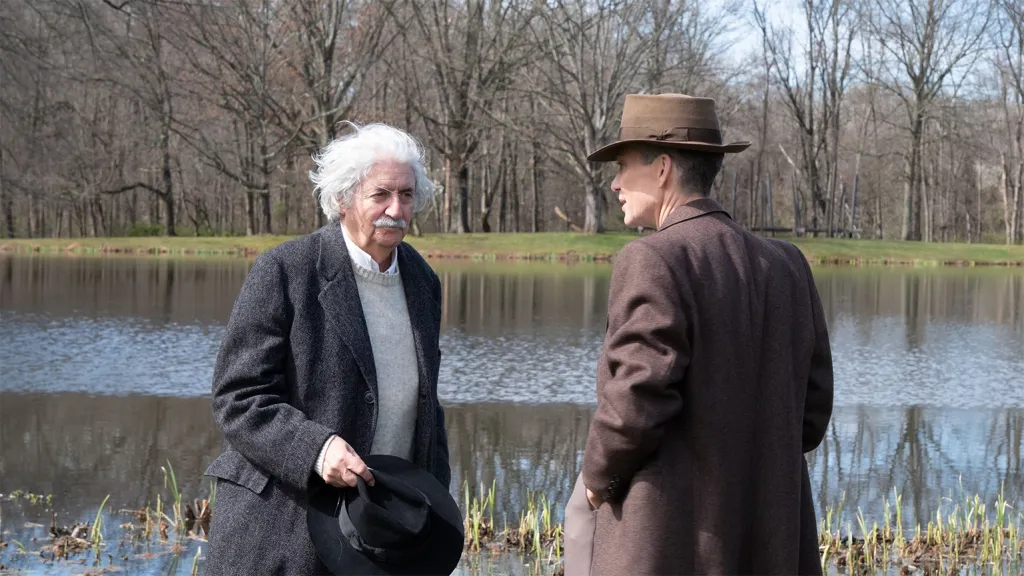Oppenheimer is about the development of the atomic bomb. However, it is also a movie about quantum physics as a way of understanding the world.
Before the atomic age, the universe was understood through Newtonian physics. In Newtonian physics, everything was causal. There were certainties. The universe was defined through the logic of cause and effect. Newton’s Third Law argued that for every action there was an equal and opposite reaction. Under this model, the universe was fundamentally knowable and even deterministic. Reality adhered to rules of action and consequence.
Quantum physics rejected this certainty in favor of probability. Suddenly, there were aspects of the universe that were unknowable. The thought experiment of Schrödinger’s cat is a great example, with the eponymous feline being both dead and alive simultaneously. With Heisenberg’s Uncertainty Principle, the German physicist (Matthias Schweighöfer) argued that one could know the position or speed of a moving particle, but never both. Knowing one would mean not knowing the other.
This was a fundamental shift in the understanding of the underlying logic of the universe. Not all physicists could make that leap into uncertainty. Albert Einstein (Tom Conti) was wary of the move away from certainties towards probabilities, believing that “God does not play dice.” J. Robert Oppenheimer (Cillian Murphy) was the greatest scientific mind of his generation because he could make that leap. He brought that science back from Europe to America, where he taught at Berkeley.
Oppenheimer doesn’t get too bogged down in technobabble and hard science, but it repeatedly stresses the underlying logic. Teaching his first class to a single student, Giovanni Rossi Lomanitz (Josh Zuckerman), Oppenheimer opens by making the argument that light is both a wave and a particle, two seemingly exclusive states of being. Lomanitz interjects that it’s impossible, but Oppenheimer cuts him off. “It’s paradoxical, but it works,” he explains.

It makes sense that writer and director Christopher Nolan would be drawn to quantum physics as a subject. Nolan’s movies are fundamentally about uncertainty and unknowability, about the limits of the human ability to know for sure. This is why certain critics mistakenly describe Nolan’s plots as “mystery boxes.” His movies typically involve mysteries, but those mysteries are often fundamentally unsolvable to the characters or are distractions from more fundamental existential questions.
In Memento, Leonard (Guy Pearce) constructs an unsolvable mystery around the death of his wife Catherine (Jorja Fox) to assuage his own guilt over her death and to give his life meaning. Lacking the ability to retain his short-term memories, Leonard can only fleetingly reach understanding with himself, and those moments are inevitably lost. He lives in a state of uncertainty, constantly having to re-evaluate his surroundings and unsure of what he is doing in a given moment or why he is doing it.
Characters in Nolan movies are often mysteries to themselves and to others. In Insomnia, Will Dormer (Al Pacino) shoots his partner Hap Eckhart (Martin Donovan) during a foggy chase. Dormer insists it was an accident, but it was a convenient one. Eckhart was about to testify to Internal Affairs, jeopardizing Dormer’s career and his convictions. Throughout Insomnia, Dormer is haunted by the possibility that — on some unconscious level — that split-second reaction wasn’t an accident.
In The Prestige, Robert Angier (Hugh Jackman) obsesses over the death of his wife (Piper Perabo) during a water tank trick. Angier demands to know which knot Alfred Borden (Christian Bale) tied, but Borden cannot tell him. “I have fought with myself over that night,” Borden confesses in his diary. “One half of me swearing blind that I tied a simple slipknot, the other half convinced that I tied the Langford double. I can never know for sure.” Angier demands, “How can he not know?”

That uncertainty drives The Prestige, perhaps the closest film in Nolan’s filmography to Oppenheimer. Struggling to experience what his wife did in her dying moments, to know what she knew, Angier takes to trying to drown himself. When Borden debuts a new magic trick, “The Transported Man,” Angier becomes obsessed with knowing for certain how his rival pulls it off. This obsession leads Angier to seek the advice of Nikola Tesla (David Bowie), to build him a machine.
Tesla builds Angier a device that literally transports him, creating a clone. Angier disguises this as a teleportation trick. The copy emerges to applause and the original is dunked in a water tank, to drown as his wife did. Every night, one version of Angier gets to know what his wife felt, but the survivor never gets to remember. Angier exists in a quantum state. He confesses that “it took courage to climb into that machine every night, not knowing if (he’d) be the man in the box or the prestige.”
In The Dark Knight, the Joker’s (Heath Ledger) backstory is constantly changing. At the climax of Dunkirk, Tommy (Fionn Whitehead) discovers that Gibson (Aneurin Barnard), who has been following him around for the whole film, is a French soldier who stole his uniform from a dead Briton. In Tenet, the Protagonist (John David Washington) and Neil (Robert Pattinson) are two friends moving in the opposite direction through time. Neil has known the Protagonist for years but is also a stranger to him. In Inception, Cobb (Leonardo DiCaprio) cannot know what is real and what is a dream.
Oppenheimer is similarly built around these uncertainties and ambiguities. The film suggests that the revolution in physics is a reflection of a much larger shift in human understanding, playing out in art, culture, music, politics, and psychology. Oppenheimer studies Picasso paintings, listens to Stravinsky’s The Rite of Spring, reads T.S. Eliot’s The Waste Land, contemplates Karl Marx’s Das Kapital, stocks his library with Sigmund Freud and Carl Jung, and learns Sanskrit to parse the Bhagavad Gita.

When he is drafted to run the Manhattan Project — the American effort to develop an atomic bomb — General Leslie Groves (Matt Damon) insists on compartmentalization. Oppenheimer comes up with the idea of building a community for scientists in Los Alamos, in the middle of the New Mexico desert. He hopes to create a safe and secure environment where his team can work isolated from the rest of the world. In some ways, this is how Oppenheimer himself has always lived, compartmentalizing his affairs and his political associations.
Oppenheimer adopts an intensely subjective perspective. This is obvious in the film’s visual language. It places the audience in the characters’ heads. When Oppenheimer is grilled on his affair with Jean Tatlock (Florence Pugh) during a hearing on his security clearance, the camera shows Oppenheimer sitting naked before the board. As his testimony continues, the scene shifts to the perspective of his wife Kitty (Emily Blunt), who imagines the affair playing out in front of her.
When William L. Borden (David Dastmalchian) tells Oppenheimer about watching German V2 rockets fly through the sky towards London from his B-52, Oppenheimer imagines himself in the back seat of the jet, watching those rockets. When Lewis Strauss (Robert Downey Jr.) argues for the hydrogen bomb, Oppenheimer imagines water rippling over the table, recalling an earlier conversation with Einstein about the inevitability of nuclear apocalypse. When he hears of Jean’s death, he imagines it as both suicide and murder, but he can never know. In Nolan’s movies, belief in objective reality is something that requires near-religious faith.
Oppenheimer uses its visual language to emphasize this subjectivity. The film unfolds in multiple parallel narratives. Oppenheimer’s story is told in color, while Strauss’ account of events plays out in black and white. The film repeatedly shows the same scenes from different perspectives, with subtle shifts in how characters are portrayed. There is no single objective perspective on events. There is no absolute truth. There is no omniscient power casting judgment. There are just competing narratives.

However, it is also worth noting what the film doesn’t show. It doesn’t depict the use of the weapon against Hiroshima and Nagasaki. While this has been the source of some criticism, it underscores the movie’s central point. As Nolan has pointed out, Oppenheimer did not experience Hiroshima and Nagasaki. The character was able to compartmentalize that. In order to continue working on the project — and perhaps retroactively to justify his work on the project — he cannot directly confront it.
Central to Oppenheimer, as with most of Nolan’s work, is the idea that people are fundamentally alien to each other and to themselves. The nuclear arms race is driven by the Cold War between the United States and Soviet Russia, because the two sides are unable to talk to one another with what Oppenheimer terms “absolute candor.” However, nations are built in the image of people. If people are fundamentally alien to one another and themselves, how can nations understand each other?
Throughout Oppenheimer, Oppenheimer is a mystery and a contradiction. At one point, he attempts to poison his teacher, Patrick Blackett (James D’Arcy), despite admitting that he liked Blackett “very much.” Characters press him to take a stance on the atomic bomb, but he refuses. “You can convince anyone of anything,” Leo Szilard (Máté Haumann) remarks. “Even yourself.” Describing him as “sphinxlike,” Edward Teller (Benny Safdie) complains, “Nobody knows what you think — do you?” It is a fair question.
As Oppenheimer unfolds, the dawning realization of the power that Oppenheimer has released seems to fracture that careful compartmentalization of his life — the barriers that he constructed to allow him to have affairs with women like Ruth Tolman (Louise Lombard) and to work on this bomb without considering the consequences. At certain points, the world around Oppenheimer seems to shake and vibrate with the force of an atomic explosion, as some greater undeniable truth about what he has done threatens to break through.
This is the real horror of Oppenheimer. The atomic bomb arrived at a point when the world shifted away from certainties and towards probabilities, where humanity lost any illusion of singular or cohesive truth. Nuclear annihilation is an existential threat powerful enough to end humankind as a species. Even the probability of such an event is a horrifying reality that must be confronted. The bleak and lingering question hanging over Oppenheimer is how humanity can be expected to understand that when it cannot even understand itself.






Published: Jul 25, 2023 11:00 am